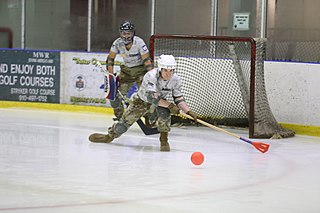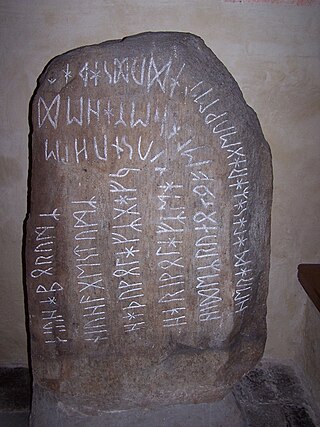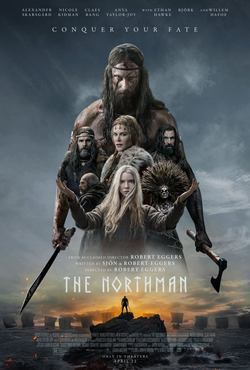The draugr or draug is an undead creature from the Scandinavian saga literature and folktales.

Hockey is a term used to denote a family of various types of both summer and winter team sports which originated on either an outdoor field, sheet of ice, or dry floor such as in a gymnasium. While these sports vary in specific rules, numbers of players, apparel, and playing surface, they share broad characteristics of two opposing teams using a stick to propel a ball or disk into a goal.

Shinty is a team sport played with sticks and a ball. Shinty is now played mainly in the Scottish Highlands and among Highland migrants to the major cities of Scotland, but it was formerly more widespread in Scotland, and was even played in Northern England into the second half of the 20th century and other areas in the world where Scottish Highlanders migrated.

In the Old Norse written corpus, berserkers were those who were said to have fought in a trance-like fury, a characteristic which later gave rise to the modern English word berserk. Berserkers are attested to in numerous Old Norse sources.

Egill's Saga or Egil's saga is an Icelandic saga on the lives of the clan of Egill Skallagrímsson, an Icelandic farmer, viking and skald. The saga spans the years c. 850–1000 and traces the family's history from Egill's grandfather to his offspring.

A face-off is the method used to begin and restart play after goals in some sports using sticks, primarily ice hockey, bandy, floorball, broomball, rinkball, and lacrosse.

Broomball is a both a recreational and organized competitive winter team sport played on ice or snow and is played either indoors or outdoors, depending on climate and location. It is a ball sport and is most popularly played in Canada and the United States.

Field lacrosse is a full contact outdoor sport played with two opposing teams of ten players each. The sport originated among Native Americans, and the modern rules of field lacrosse were initially codified by Canadian William George Beers in 1867. Field lacrosse is one of three major versions of lacrosse played internationally. The rules of men's lacrosse differ significantly from women's field lacrosse. The two are often considered to be different sports with a common root. An outdoor six-a-side version, lacrosse sixes, was established in 2021 and features six players per team, reduced field size, and shorter duration to be conducive for daily tournament play. Another version, indoor box lacrosse, is also played under different rules.

Gaelic games are a set of sports played worldwide, though they are particularly popular in Ireland, where they originated. They include Gaelic football, hurling, Gaelic handball and rounders. Football and hurling, the most popular of the sports, are both organised by the Gaelic Athletic Association (GAA). Women's versions of hurling and football are also played: camogie, organised by the Camogie Association of Ireland, and ladies' Gaelic football, organised by the Ladies' Gaelic Football Association. While women's versions are not organised by the GAA, they are closely associated with it but are still separate organisations.

Floor hockey is a broad term for several indoor floor game codes which involve two teams using a stick and type of ball or disk. Disks are either open or closed but both designs are usually referred to as "pucks". These games are played either on foot or with wheeled skates. Variants typically reflect the style of ice hockey, field hockey, bandy or some other combination of sport. Games are commonly known by various names including cosom hockey, ball hockey, floorball, or simply floor hockey.

Blót or geblōt are religious ceremonies in Germanic paganism that centred on the killing and offering of an animal to a particular being, typically followed by the communal cooking and eating of its meat. Old Norse sources present it as a central ritual in Old Nordic religion that was intimately connected with many wider aspects of life. Large blót are often described as taking place in halls, organised by the rulers of the region who were expected to carry out the practice on behalf of the people. Blót were central to the legitimacy of rulers and Christian rulers refusing to hold them were at times replaced by more willing alternatives and driven out of the land. Smaller, household blót were sometimes recorded as being led by women. Beyond strengthening legitimacy for the ruling elites, the performance of blót was often in order to ensure the fertility of the land, a good harvest and peace, although they are also recorded as being performed for divination or to achieve desired results in legal matters.

Egil Skallagrímsson was a Viking Age war poet, sorcerer, berserker, and farmer. He is known mainly as the anti-hero of Egil's Saga. Egil's Saga historically narrates a period from approximately 850 to 1000 AD and is believed to have been written between 1220 and 1240 AD.

Eyrbyggja saga is one of the Icelanders' sagas; its title can be translated as The Saga of the People of Eyri. It was written by an anonymous writer, who describes a long-standing feud between Snorri Goði and Arnkel Goði, two strong chieftains within the Norse community that settled in Iceland. The title is slightly misleading as it deals also with the clans from Þórsnes and Alptafjörðr on Iceland. The most central character is Snorri Þorgrímsson, referred to as Snorri Goði and Snorri the Priest. Snorri was the nephew of the hero of Gísla saga, and is also featured prominently in Njáls saga and Laxdœla saga. Another main interest of the Eyrbyggja Saga is to trace a few key families as they settled Iceland, specifically around the Snæfellsnes peninsula.
Króka-Refs saga or the Saga of Ref the Sly is one of the Icelanders' sagas. Written in the 14th century the saga relates the adventures of Ref Steinsson, whose unpromising origins lead him to greatness in both combat and subterfuge.

The history of hurling is long and often unclear, stretching back over three millennia. References to stick-and-ball games are found in Irish mythology. The game is thought to be related to the games of shinty that is played primarily in Scotland, cammag on the Isle of Man and bandy that was played formerly in England and Wales. There is evidence that in ancient times a similar game called Knattleikr was also played in Iceland, with the Icelandic sagas, "suggesting that it was something that was brought from the Gælic area to Iceland".

Snorri Þorgrímsson or Snorri Goði was a prominent chieftain in Western Iceland, who featured in a number of Icelandic sagas. The main source of his life is the Eyrbyggja saga, in which he is the main character, although he also figures prominently in Njál's saga and the Laxdæla saga. Snorri was the nephew of Gísli Súrsson, the hero of Gísla saga, and son of Þorgrímr Þorsteinsson whom Gísli killed in revenge to fulfill a blood-oath.
The term "halberd" has been used to translate several Old Norse words relating to polearms in the context of Viking Age arms and armour, and in scientific literature about the Viking Age. In referring to the Viking Age weapon, the term "halberd" is not to be taken as referring to the classical Swiss halberd of the 15th century, but rather in its literal sense of "axe-on-a-pole", describing a weapon of the more general glaive type.

Bando is a team sport – related to field hockey, hurling, shinty, and bandy – which was first recorded in Wales in the eighteenth century.

The Northman is a 2022 American epic historical action film directed by Robert Eggers from a screenplay he co-wrote with Sjón. Based on the legend of Amleth, the film stars Alexander Skarsgård, Nicole Kidman, Claes Bang, Anya Taylor-Joy, Gustav Lindh, with Ethan Hawke, Björk, and Willem Dafoe. It focuses on Amleth, a Viking prince who sets out on a quest to avenge the murder of his father. The film is heavily influenced by Norse mythology.















